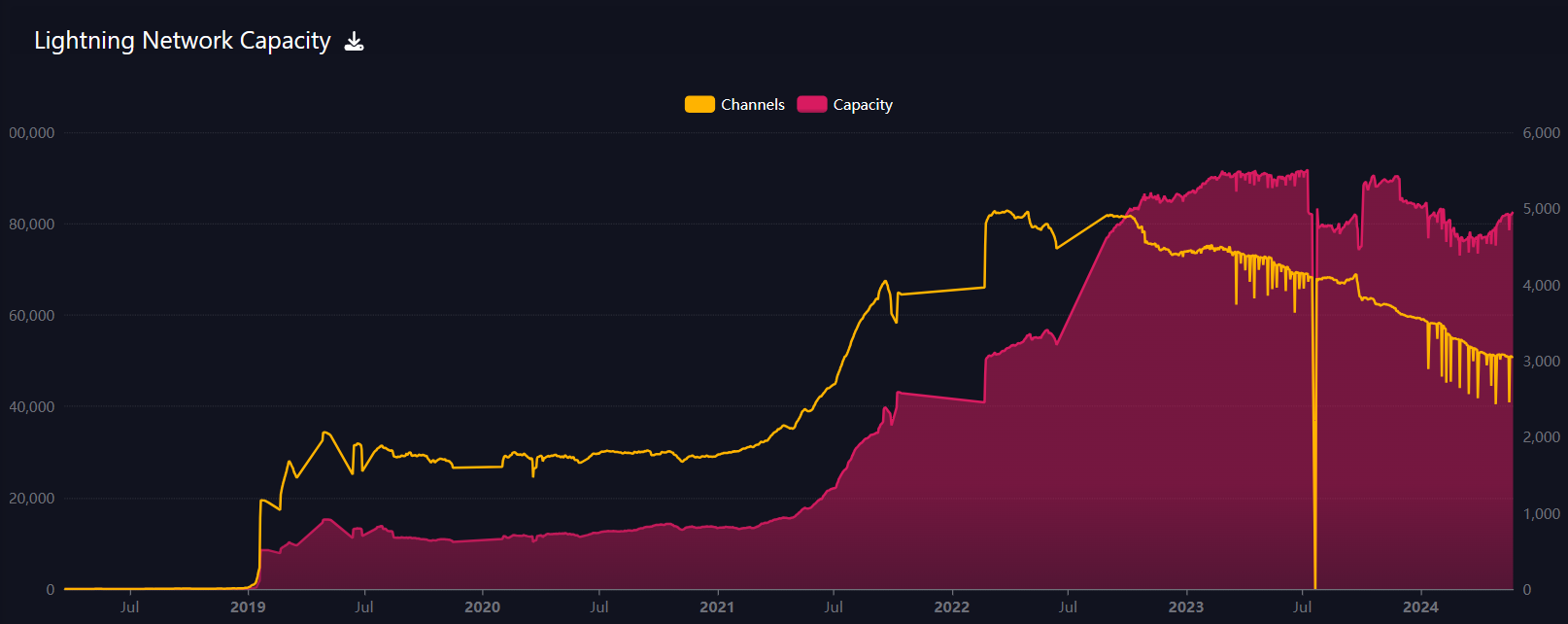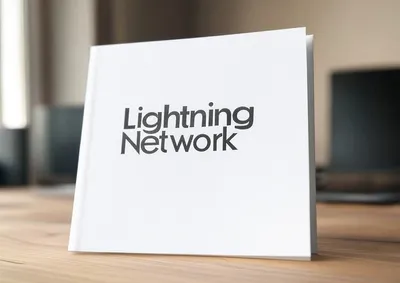What is Lightning Network and How Does It Work?
Discover what the Lightning Network is and how it revolutionizes cryptocurrency transactions. Learn about its benefits, challenges, and potential impact on the future of decentralized finance.
•
7 min read

What Is the Lightning Network?
The Lightning Network is a second-layer, also known as a Layer-2, solution designed to address the scalability issues faced by Bitcoin and several other Proof-of-Work cryptocurrencies. It is a decentralized network that enables instant, high-volume micropayments between users. By creating a network of bidirectional payment channels, the Lightning Network allows transactions to be processed off-chain, thereby reducing congestion and fees on the main blockchain.
How Lightning Network Aims to Solve Scalability Problems in Blockchain Technology
Scalability is one of the most significant challenges facing blockchain technology. Bitcoin, the pioneering cryptocurrency, can only handle about 7 transactions per second (TPS) due to its block size and block interval constraints. This limitation leads to slow transaction times and high fees during peak periods. The Lightning Network aims to solve these problems by enabling transactions to be processed off-chain.
By moving transactions off the main blockchain, the Lightning Network reduces the load on the primary network. This approach allows for a higher volume of transactions to be processed simultaneously, making micropayments feasible and cost-effective. The result is a faster, cheaper, and more scalable system that can handle a much larger number of transactions without compromising the security of the blockchain.
How Does the Lightning Network Work?
The Lightning Network operates through a network of payment channels. Here's a step-by-step overview of how it works:
Opening a Payment Channel
Creating a Multisignature Wallet: Two parties who wish to transact create a multisignature wallet, which requires both parties to sign off on any spending. They both deposit a certain amount of Bitcoin into this wallet, which is recorded on the blockchain.
Funding the Channel: This initial transaction, known as the funding transaction, opens the payment channel. The deposited funds are then available for off-chain transactions between the two parties.
Conducting Transactions
Off-Chain Transactions: Once the payment channel is open, the two parties can conduct an unlimited number of transactions between themselves without broadcasting them to the blockchain. These transactions update the balance of the funds in the multisignature wallet.
Transaction Security: Each transaction is secured through a series of cryptographic signatures and commitments, ensuring that neither party can cheat by broadcasting an outdated transaction.
Closing the Payment Channel
Broadcasting the Final Transaction: When the parties are done transacting, they close the payment channel by broadcasting the final balance to the blockchain. This transaction reflects the net result of all off-chain transactions.
Settlement on the Blockchain: The final transaction is verified and added to the blockchain, updating the balances of the two parties.
Routing Payments Through the Network
The Lightning Network also supports payments between users who do not have a direct payment channel. This is achieved through a network of interconnected channels, where payments are routed through multiple hops to reach the final recipient. Each intermediate node in the path helps forward the payment, earning a small fee for their service.
Benefits of the Lightning Network
The Lightning Network offers numerous advantages that make it a compelling solution for enhancing the functionality and efficiency of blockchain technology. By addressing key issues such as speed, cost, scalability, and privacy, the Lightning Network is poised to play a critical role in the evolution of decentralized finance.
By addressing these issues, LN becomes an attractive option for a wide range of applications, from everyday retail transactions to complex financial operations, ultimately contributing to broader adoption and integration within the broader cryptocurrency ecosystem.
Speed and Efficiency
One of the most significant benefits of the Lightning Network is the speed of transactions. By moving transactions off-chain, payments can be processed almost instantly, regardless of the network's overall congestion. This speed is crucial for use cases like retail payments and micropayments, where quick transaction times are essential.
Lower Transaction Fees
On-chain transactions can become expensive during periods of high demand, as users compete to have their transactions included in the next block. The Lightning Network mitigates this issue by enabling off-chain transactions, which are typically much cheaper. This reduction in fees makes it practical to conduct small-value transactions, which would be cost-prohibitive on the main blockchain.
Scalability
The Lightning Network significantly enhances the scalability of the Bitcoin network. By processing transactions off-chain, the Lightning Network can handle a much larger volume of transactions compared to the main blockchain. This scalability is essential for Bitcoin to achieve widespread adoption as a medium of exchange.
Privacy
Off-chain transactions on the Lightning Network offer improved privacy compared to on-chain transactions. Since only the opening and closing transactions are recorded on the blockchain, the details of individual transactions remain private. This feature is beneficial for users who wish to keep their transaction history confidential.
Challenges and Limitations
While the Lightning Network presents many benefits, it is not without its challenges and limitations. Understanding these hurdles is crucial for developers, users, and stakeholders as they navigate the adoption and implementation of this technology. Addressing these issues will be key to realizing the full potential of the Lightning Network and ensuring its long-term success and viability in the cryptocurrency ecosystem.
Network Liquidity
For the Lightning Network to function efficiently, there must be sufficient liquidity within the network. This means that enough funds must be available in payment channels to facilitate transactions. Low liquidity can lead to failed transactions or increased routing fees, undermining the network's effectiveness.
Technical Complexity
Setting up and maintaining a Lightning Network node requires a certain level of technical expertise. Users must understand the intricacies of payment channels, routing, and network management. This complexity can be a barrier to entry for less tech-savvy users.
Security Risks
While the Lightning Network is designed to be secure, it is not without risks. Users must ensure that their nodes are correctly configured and that they keep their software up to date to protect against potential vulnerabilities. Additionally, there is a risk of funds being locked in a payment channel if one party goes offline.
Network Centralization
There is a concern that the Lightning Network could become centralized over time, with a few large nodes handling most of the transaction routing. This centralization could undermine the decentralized ethos of Bitcoin and make the network more vulnerable to attacks.
At Stroom, we recognize the importance of these issues and will cover the risks and challenges of the Lightning Network in greater detail in a separate blog article. Stay tuned for more insights and in-depth analysis.
Lightning Network Adoption and Growth
Despite its challenges, the Lightning Network has seen significant adoption and growth since its launch. Many businesses and individuals are now using the network for everyday transactions, and the number of nodes and payment channels continues to increase.
Merchant Adoption
A growing number of merchants are accepting payments via the Lightning Network. This trend is driven by the network's ability to offer fast, low-cost transactions, making it an attractive option for businesses looking to accept cryptocurrency payments.
The adoption is further fueled by integration with social media platforms like Nostr, which supports various LN wallets and has seen significant user sign-ups.
Wallet Support
Several popular cryptocurrency wallets now support the Lightning Network, making it easier for users to access and use the network. These wallets provide user-friendly interfaces and tools to help manage payment channels and conduct transactions.
Integration with Exchanges
Major cryptocurrency exchanges, including Bitfinex, Kraken, Bitstamp, Binance, and America’s largest digital assets trading platform Coinbase, are also integrating the Lightning Network, allowing users to deposit and withdraw funds quickly and cheaply. This integration is crucial for increasing the network's liquidity and encouraging broader adoption.
💡 Fun fact
The first cryptocurrency exchange to enable Lightning Network payments was Vaultoro in May 2018.
“Bitcoin is one of the greatest peaceful revolutions the world has ever seen,” Vaultoro CEO Joshua Scigala said back at the time. “Why? Because it’s voluntarily bringing people back to asset-based money and giving them a way out of controlled debt-based fiat currency. Many won’t understand this important difference, but it doesn’t matter as they will come in due to mad gains in the speculative markets or basic borderless utility.”
Development and Innovation
The Lightning Network is a rapidly evolving technology, with ongoing development and innovation aimed at improving its performance and usability. New features and enhancements are regularly introduced, addressing existing limitations and expanding the network's capabilities.
As of the end of May 2024, the Lightning Network's capacity is sitting just below 5,000 BTC, with the number of nodes being close to 13,000 and more than 50,000 open payment channels. This growth is partly due to increased adoption in emerging markets like South America and Africa, where mobile payment applications such as Strike have been instrumental. For instance, Strike's LN-based remittance service launched in Africa and the Philippines, offering low-cost transfers and boosting adoption.

Source: mempool.space
Future of the Lightning Network
The future of the Lightning Network looks promising, with several potential developments on the horizon.
Improved Usability
Efforts are underway to make the Lightning Network more user-friendly, reducing the technical complexity associated with setting up and using the network. Simplified interfaces and automated channel management tools will help lower the barrier to entry for new users.
Enhanced Privacy
Privacy improvements are a key focus for the Lightning Network's development community. Advanced cryptographic techniques, such as Schnorr signatures and Taproot, are being explored to enhance the privacy of transactions on the network.
Cross-Chain Compatibility
There is growing interest in making the Lightning Network compatible with other blockchains. Cross-chain atomic swaps and interoperability protocols could enable seamless transactions between different cryptocurrencies, further expanding the network's utility.
Increased Adoption
As the Lightning Network continues to prove its value, adoption is expected to grow. More merchants, exchanges, and users will likely embrace the network, leading to increased liquidity and improved transaction efficiency.
Regulatory Considerations
The regulatory landscape for cryptocurrencies is constantly evolving, and the Lightning Network will need to navigate these changes. Ensuring compliance with relevant regulations while maintaining the network's decentralized nature will be a key challenge moving forward.
Conclusion
The Lightning Network represents a significant advancement in the world of cryptocurrency, addressing many of the scalability and efficiency issues that have hindered blockchain technology. By enabling fast, low-cost, and private transactions, the Lightning Network has the potential to revolutionize how we conduct digital transactions. While challenges and limitations remain, the ongoing development and growing adoption of the network suggest a bright future ahead. As the Lightning Network continues to evolve, it is likely to play a crucial role in shaping the future of decentralized finance and the broader cryptocurrency ecosystem.
*****
We trust you've found this article helpful. To learn more about Stroom, access detailed information about our technology, or explore how you can join the ecosystem, visit the following resources:
Official website: https://stroom.network/
Whitepaper: https://stroom.network/Primer.pdf
Twitter (X): https://twitter.com/StroomNetwork
Discord: https://discord.gg/DZ53WjDXz9
Telegram: https://t.me/stroomnetwork

Stroom DAO
View our other posts

Bitcoin Without Borders: Unlocking Bitcoin's Multi-Chain Potential
Since the birthday of the first Bitcoin block on January 3, 2009, a new era of financial assets has begun - the cryptocurrency era. Unmatched security, permissionlessness, and decentralization cemented Bitcoin'
Stroom DAO

Lightning Network in 2025: Bitcoin’s Transformation into Everyday Money
Bitcoin’s Lightning Network is transforming from an experiment into a global payment system, making everyday transactions faster and cheaper.
Stroom DAO

Lightning Network: Celebrating 9 Years of Innovation
The Lightning Network whitepaper was unveiled on January 14, 2016, introducing a transformative layer atop Bitcoin for instant, scalable transactions.
Stroom DAO